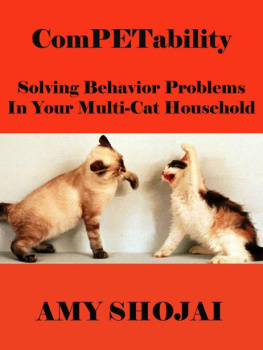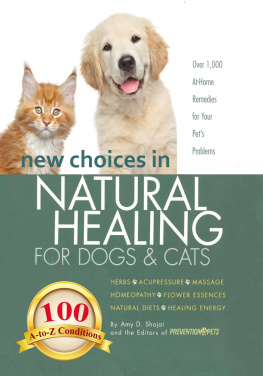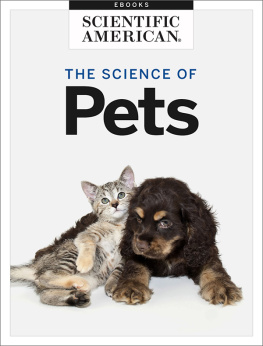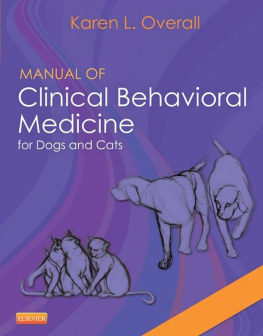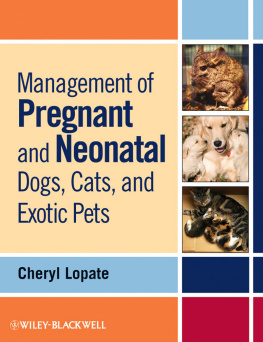ComPETability: Solving BehaviorProblems
In Your Multi-CAT Household
By AMY SHOJAI, CABC
Contents
PART ONE: UNDERSTANDING COMPETABILITY
Chapter 1: THE JOYS OF MULTIPLE CATS
People love cats, and pets love us back.This treasured relationship has developed over many thousands of years, andcontinues to evolve today. Felines reflect the best parts of human nature:honesty, confidence, loving personalities, with an unbridled passion for life.
According to the American Pet ProductsAssociation 2011-2012 National Pet Owners Survey:
Approximately86.4 million owned cats are in the United States
Thirty-threepercent of U.S. households own at least one cat
Fifty-twopercent of owners own more than one cat
Onaverage, owners have two cats (2.2)
Morefemale cats are owned (80 percent) than male cats (65 percent)
Twenty-onepercent of owned cats were adopted from an animal shelter
For many of us, pets are furry familymembers, surrogate children, purring confidants, and a nonjudgmental supportsystem that buoys our spirits. What a gift that they also return our love!
If a single cat provides these benefits,two or more multiplies the pleasure. Sharing your home with more than onefur-kid offers the best of all possible worlds, allowing you and your family toexperience the myriad personalities cats represent. Having more than a singlecat means more work, but the benefits are worth it.
Young pets clown and play, prompting ourforgiving laughter even when they make mistakes. Who could resist the kittensnoozing amidst the unrolled flourish of toilet paper? Adult cats know whenweve had a hard day at work, and silently commiserate with welcome lapsnuggle, lick away tears, or transform frustration to fun with a spontaneousgame of ankle tagged pets represent milestones in human lives, because theystood by your side through the good, the bad, and the challenging, a constantreminder of love and support. When you have a couple of cats you increase thepotential to have a purrfect pet partnership for every situation.
Cats come in an amazing array of looks andpersonalities so you can always find the right match when adding a new kid toyour family. Many pets develop strong, loving relationships with each other. Aconfident pet can help bring a shy one out of her shell, while high energyyoungsters give stuck-in-the-mud older animals a fun kick in the tail.
Sharing your home with a clowder of catsmeans all the humans in the house have a good chance of finding their heart catable to share not only love, but even special interests. For instance, artisticowners relish the introspection and inspiration of a furry muse. A variety ofpeople-pet activities are available such as feline agility that increases thepleasure for both you and your pets. Refer to the Appendix for a list of someof these resources.
THEPET GENERATION
There are several reasons for thecurrent surge in multiple pet families. You may be adopted by a stray mothercat with a litter on the way, and end up keeping some or all of the offspring.But most likely, the makeup of your human family evolves, prompting change inthe pet count.
Blended families combine pets from bothhouseholds when couples re-marryhis cats and her kittens. A newly divorcedadult child may return home and bring her feline friend to join your existingpet family. Situations in which a single adult family member or friend becomesill or dies may leave you to care for the pets. More and more, ownersunexpectedly find themselves unprepared to face these situations, since theynever anticipated having to deal with interspecies or multiple petrelationships.
Today, equal-opportunity pet loversdont want to settle for one or the otherthey enjoy the unique qualities ofcats and dogs and share their homes with both. Dogs encourage social contact andinteraction. Walking a dog guarantees meeting the neighbors and other doglovers, and you get exercise along the way. Interacting with dogs is a pleasantand painless way to increase human exercise and promote our own health. You canfind out more specifics on integrating dogs and cats, or dog-to-dog issues, inthe books ComPETability: Solving Behavior Problems In Your CAT-DOG Household,and ComPETability: Solving Behavior Problems In Your Multi-DOG Household.
Cats seem to fulfill a more spiritualneed, and appeal to our introspective side. Because they do not require outdoorexercise or bathroom breaks, cats may be more convenient for less active peopleor those who must spend long periods of time away from home. Felines may not beable to jog with an owner, but they promote emotional health benefits as wellas dogs do.
Modern pet owners recognize that catshave social and emotional needs, and try to satisfy them. People facing careerdemands that keep them apart from their pet for long work hours may try tobalance the animals increased alone time by matchmaking him with a furrycompanion. In one American Animal Hospital Association survey, 44 percent ofpet owners acquired a pet simply to keep another pet company.
NOBODYSPERFECT
More pets double the fun, but alsoincrease the potential for problems, today more than ever before. Historically,owners living in rural communities enjoyed feline companionship with fewconflicts, since cats spent a large percentage of their time in the back yard,the barn or the field. That dynamic changed when pets moved into the familyroom, and were asked to co-exist.
It would be ideal if all our cats lovedeach other at first sight, played nicely together, and read our minds so theynever made behavior mistakes. The truth is all owners of multiple pets will befaced with minor-to-major behavior problems. If youre experiencing problems,you are not alone!
When we welcome a cat into our lives andhomes, we must accept that they are individuals with very different needs anddesires. Just as human siblings dont always agree, a few squabbles areinevitable. But that does not mean owners or pets must accept rude behavior,irritating or dangerous antics, or constant warfare.
The right pet matchmaking choices mustbe considered to keep the fur from flying. While we love having more than onepet, the potential for conflict increases when multiple animals share the samehouse or apartment, the same roomssometimes the same bedas human familymembers. Conflict upsets the pets physical and emotional health, createsstressful or dangerous behavior problems, and damages the loving bond withowners.
WHATSIN THE BOOK
Youre reading this book because youalready know how much fun multiples can be, but you anticipate or are alreadychallenged with behavior issues inherent to loving more than one pet. ComPETabilityprovides expert behavior and care information for cohabiting cats and offersthe tools needed to make educated matchmaking pet choices, prevent potentialproblems, and offer solutions when troubles occur.
You wont find the answer to everybehavior question here, though. While much of the information in this booktranslates to single pet homes, and youll sometimes be asked to train pets oneat a time, the focus is on behavior problems and solutions of multiples. Iveincluded the most common behavior challenges that directly impact the other catsliving in the house.
For example, you wont find directadvice about WHAT to feed your cats, but instead Ive provided tips on HOW tomanage dinnertime so all the cats munch from the correct bowl and dontinterfere with each others nutrition. Rather than a section on housetrainingyour new kitten, discover practical tips for fixing bathroom problems that areprompted by the presence of other cats.
The majority of the book dealsexclusively with how cats interact and impact each, and ways to manage this tofix or prevent behavior problems. Expanded information is included inaggression and introduction sections, though, since these dangerous behaviorsnot only affect the other animals but also the owners who must manage theproblem. The stress of living in a multiple cat home can increase aggressiontoward humans in the house or even strangers who visit. Helping your catsaccept human family members, children, babies and friends is a vital part of ahappy blended pet family.

